Part of a series of articles titled Alaska Park Science - Volume 19, Issue 1 - Below the Surface: Fish and Our Changing Underwater World.
Article
Marine Protected Area Research in Glacier Bay Leads to Insights into Halibut Behavior
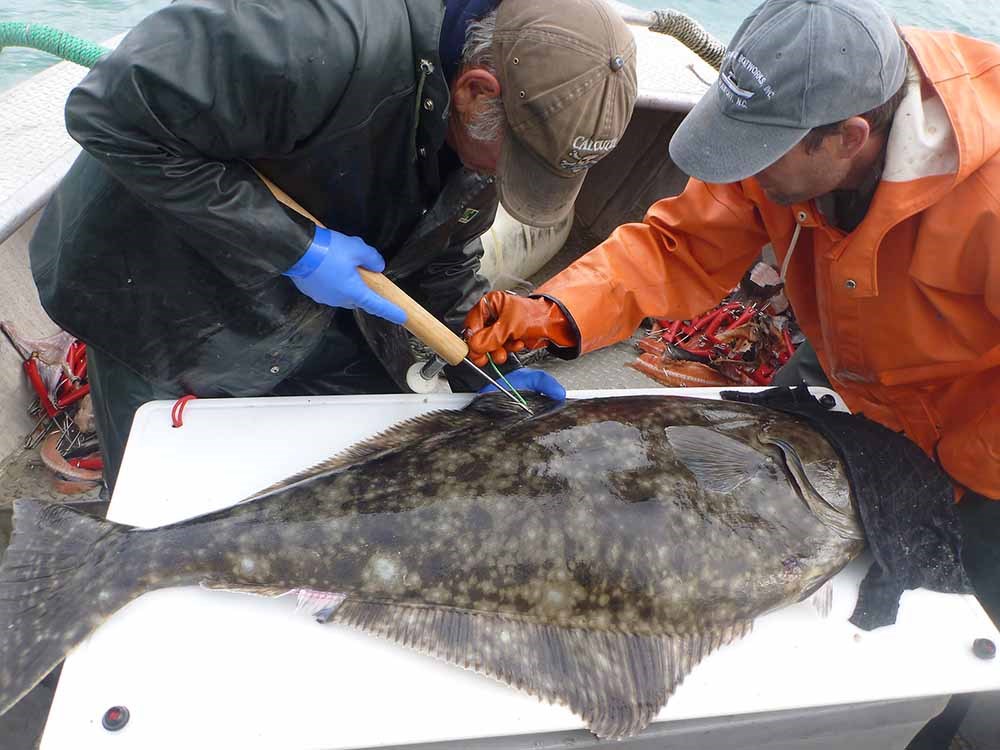
UNIVERSITY OF ALASKA FAIRBANKS/KEVIN SIWICKE
Pacific halibut (Hippoglossus stenolepis) is an iconic fish species in the North Pacific Ocean due to its large size and economic, ecological, and cultural importance. Pacific halibut (referred to subsequently as “halibut”) is one of the largest flatfish species, reaching lengths of almost nine feet (2.7 m) and weighing up to 500 pounds (227 kg; Mecklenburg et al. 2002). It is highly sought by commercial, sport, and subsistence fisheries for the large, mild, and delicate fillets it provides.
Halibut is one of the most important commercially fished species in Glacier Bay National Park and Preserve (GBNP), where commercial fishing has occurred since the early 1950s (Mackovjak 2010). In 1990, the Alaska Wildlife Alliance sued the National Park Service for allowing commercial fishing to occur in GBNP (Alaska Wildlife Alliance v. Jensen). Commercial extraction activities are not allowed in parks unless specifically authorized by the park’s enabling legislation; commercial fishing was not authorized in GBNP’s enabling legislation (1916 Organic Act, Pub.L. 64–235, H.R. 15522, 39 Stat. 535). In addition, motorized vessels were prohibited in portions of the park designated as Wilderness Waters under the Alaska National Interest Lands Conservation Act (ANILCA) of 1980. This suit initiated a dialogue about commercial fishing in GBNP and the National Park Service (NPS) began to discuss plans for implementing commercial fisheries closures in part or all of GBNP marine waters (Mackovjak 2010).
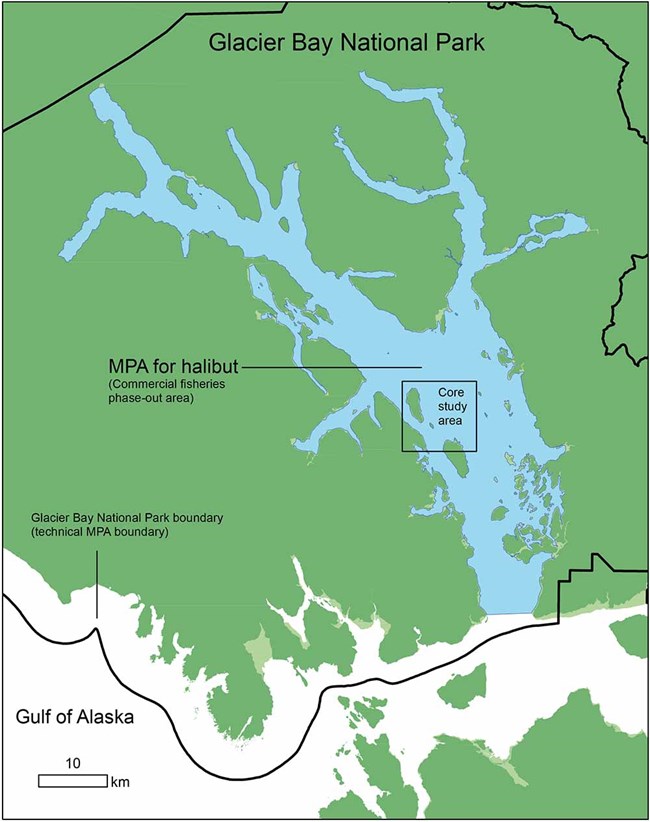
The core study area for the 2013 research is indicated by the black box in the middle of the MPA.
Congress passed legislation in 1999 to close all commercial fisheries (not including charter fishing) in the interior waters of GBNP known as “Glacier Bay Proper” (Figure 1). The commercial halibut fishery is being phased out by allowing existing fishers to continue fishing until they retire. In 2009, Glacier Bay was designated a marine protected area (MPA) and thus joined a nation-wide system of MPAs designed to advance marine conservation and sustainable use. Although the technical boundary for the Glacier Bay National Park Marine Protected Area extends to the outside waters, here we refer to the interior waters as “the MPA” because the majority of commercial fishing and vessel traffic regulation by the NPS occurs there.
Closing areas to fishing can lead to increases in biomass, size, and diversity of fishes within the closed areas (Edgar et al. 2014). However, information on fish movement patterns is critical for understanding whether specific area closures are likely to provide such benefits. For example, increases in fish abundance and size structure can occur in a MPA that is large enough to encompass the range of typical fish movements (Gruss et al. 2011). However, when plans for fisheries closures in GBNP were first discussed in the early 1990s, very little information on small-scale movement patterns of halibut existed that would allow insights into potential benefits of fisheries closures for halibut in GBNP. On the contrary, because halibut are strong swimmers capable of traveling long distances (Skud 1977, Loher and Seitz 2006), MPAs were not expected to be an effective halibut management strategy.
Using Acoustic Telemetry and Pop-up Satellite Archival Tags to Track Halibut Movements
To address the lack of movement information for halibut in Glacier Bay, NPS researchers initiated an acoustic telemetry research project in 1991 (Nielsen et al. 2014). Acoustic telemetry research is conducted by attaching an electronic tag to the fish that transmits a ping; when the ping is detected by a hydrophone on a vessel or a stationary mooring, a position for the tagged fish can be estimated. When the first acoustic-tagged halibut was released, the researchers expected it to swim away rapidly, possibly leaving the park in a matter of hours. They were prepared to follow the tagged halibut with a hydrophone-equipped research vessel around the clock for several days. But this first tagged halibut did not lead the researchers on a non-stop multi-day tracking adventure. Instead, it remained in the vicinity of the release location for days that turned into weeks and months. After the third year of research, results from tracking 43 acoustic-tagged adult halibut documented that halibut in Glacier Bay exhibited a strong tendency to spend most of their time within very small areas: most tagged halibut limited their movements to a radius of 0.6 miles (1 km). Some tagged fish were observed to depart their “halibut homes” temporarily but eventually returned, demonstrating the ability to navigate back to previously occupied locations (Nielsen et al. 2014). The results of this first acoustic telemetry study suggested that after commercial fishing is eventually phased out (estimated to occur between 2040 and 2050), the MPA is likely to protect adult halibut from commercial harvest during the summer because of their limited range of movements during the summer months.
However, because adult halibut are known to undertake large-scale migrations during winter to spawn (Loher and Seitz 2006, Loher and Seitz 2008), information on year-round movement of halibut relative to MPA boundaries also was needed to assess its potential effectiveness as a refuge from commercial harvest that operates approximately nine months of the year. Therefore we initiated a second tagging study in 2013 to characterize seasonal and annual movement patterns of adult halibut in and around the MPA (Nielsen and Seitz 2017). We used Pop-up Satellite Archival Tags (PSATs) to characterize annual movement patterns year-round (inside and outside the MPA) and acoustic tags to further characterize small-scale movement patterns within the MPA during summer. PSATs are external electronic tags that are attached to halibut with a dart and tether. They record continuous depth, temperature, and light data until they are programmed to release from the fish. Then they float to the surface of the ocean and transmit their data to satellites. PSAT data can then be used to infer a fish’s location for each day by comparing data from the PSAT to known conditions in the study area.
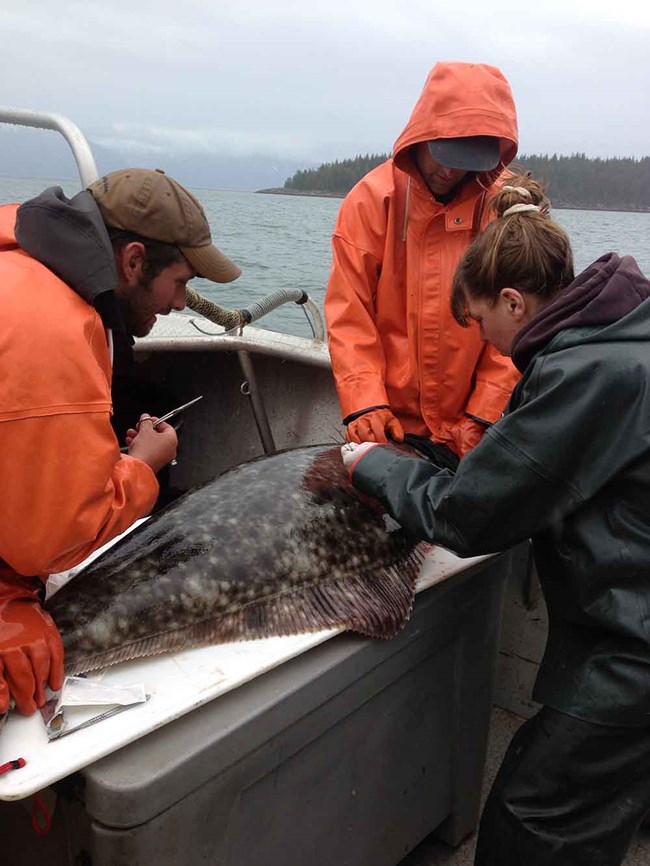
NPS/JOHN RODSTROM
We attached 25 PSATs to adult halibut ranging from 3.4 to 5.6 feet in total length (1.0 – 1.7 m) caught on longlines inside the MPA during the summer (Figure 2). Ten PSATs were programmed to release from the fish in winter, when migrating fish were expected to leave the MPA on spawning migrations, and 15 PSATs were programmed to release from the fish one full year after they were tagged. Depth and temperature data from PSATs were used to infer whether fish were inside or outside of the MPA for each day that the tag was attached to the fish. Fifteen of the halibut tagged with PSATs also received a surgically implanted acoustic transmitter. Acoustic-tagged fish were tracked every other week for two months during the summer of 2013 and again during June and July of 2014. Tagged halibut could be detected within a radius of 0.3 miles (500 m) and locations could generally be determined with a precision of 492 feet (150 m).
The results from the second satellite tagging study suggest that not only do adult halibut in GBNP occupy small “homes” within the MPA during the summer, but they can leave the MPA during the winter and return to their previously occupied locations within the MPA. Estimated summer behavior and movement scales were remarkably similar between the older and newer studies (Figure 3). We described the spatial scale of areas the tagged fish occupied (“home ranges”) as the radius of a circle that describes the average range of fish movement. In the 1991 movement study, the average movement radius was 1,315 feet (401 m) to 1,693 feet (516 m; n=27). Individual movement radii ranged from 341 feet (104 m) to 4,902 feet (1,494 m). The average movement radius for the 2013 study was 1,591 feet (485 m) to 2,654 feet (809 m; n=12) and individual home range sizes ranged from 282 feet (86 m) to 5,594 feet (1,705 m).
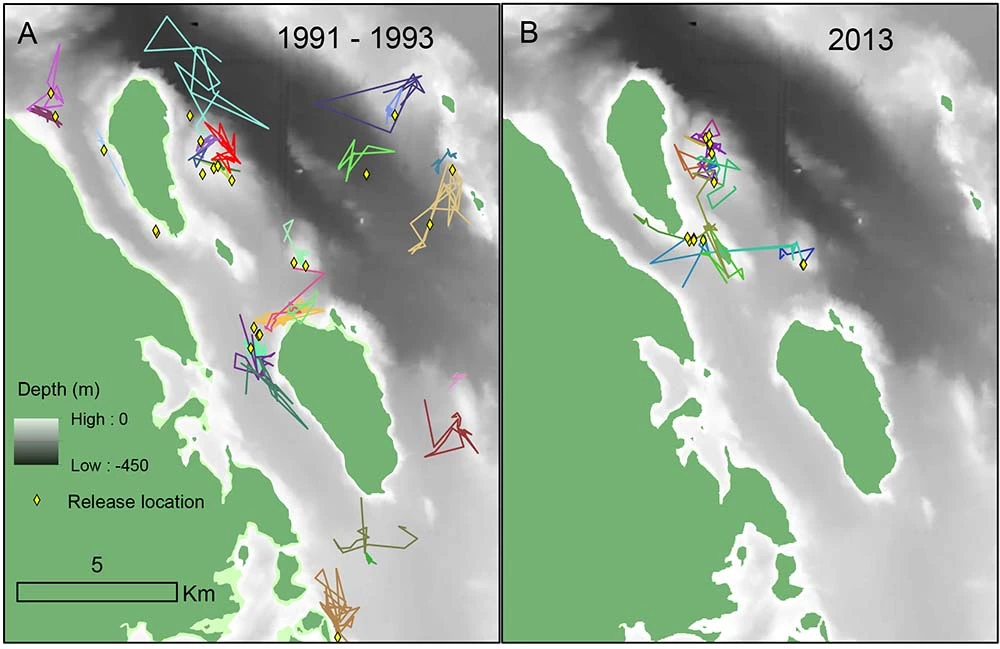
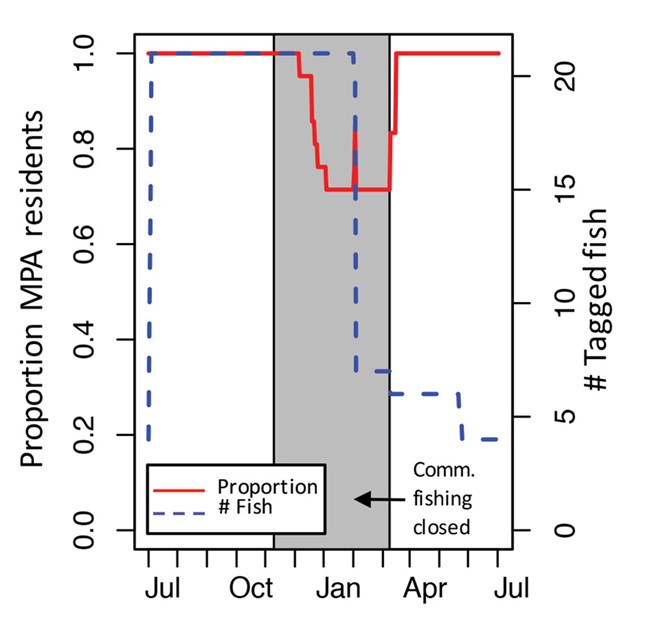
We also found high rates of MPA year-round residency. The majority of fish with PSATs that provided data (15 out of 21) remained within the MPA during the winter. However, six halibut did leave the MPA in December, and four of the six migrants returned to the MPA by mid-March. Migration largely coincided with the closure of the commercial fishery during winter (Figure 4), so tagged fish were vulnerable to commercial fishing outside the MPA for only a very small proportion of their migration time.
We were also able to determine that scales of movement from year to year are just as small as the movement scales observed within a summer. By double-tagging halibut with both PSAT and acoustic tags, we were able to determine that one migrant fish returned to within 0.6 miles (1 km) of its release location following a spawning migration to a location outside of the MPA (likely somewhere in the Gulf of Alaska). The median movement distance between the release locations and locations determined the following summer was 0.8 miles (1.3 km) and ranged from 0.2 miles (0.3 km) to 16.5 miles (26.5 km; n=14).
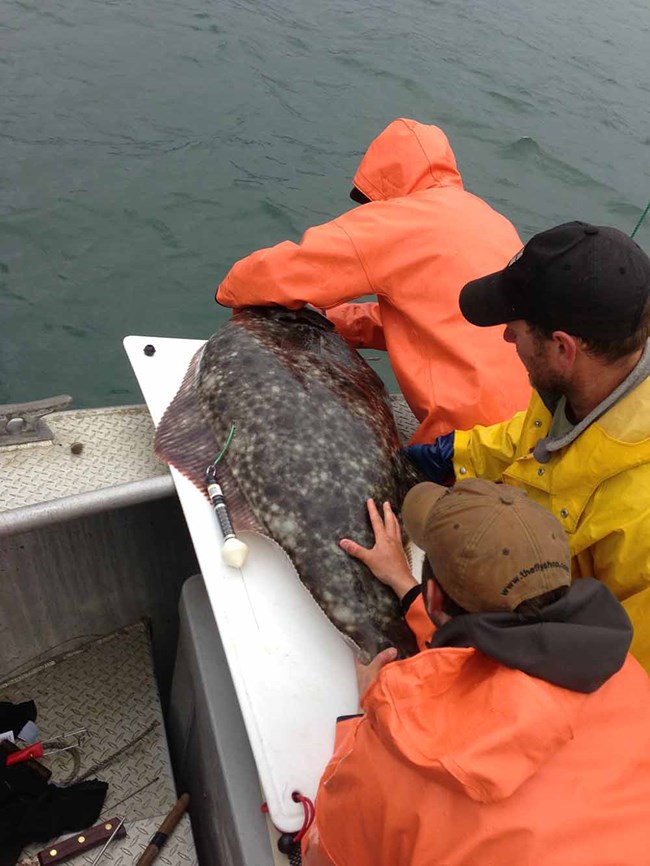
NPS/JOHN RODSTROM
Implications for Halibut Management
The halibut movement studies conducted in Glacier Bay as part of marine protected area research have provided important insights into halibut behavior that may have implications for the management of halibut at larger scales. Both studies indicate that Glacier Bay halibut are capable of establishing small homes from which they may leave, but to which they can return. This behavior is similar to lingcod (Beaudreau and Essington 2011) and certain rockfish species (Mitamura et al. 2012), though the spatial scales for halibut in Glacier Bay are slightly larger. Important work remains to understand how movement patterns and spatial scales are related to geographic region, habitat type, or halibut size and to further understand the prevalence of this behavior in the overall Pacific halibut population. However, if seasonal and annual site fidelity at small spatial scales proves to be a common behavior throughout their range of distribution, halibut populations may have more spatial structure than currently thought. Spatial population structure has implications for stock assessment (Cadrin and Secor 2009) and the potential for local depletion (Trumble et al. 1991, Hare 2005) among other management considerations. Recent PSAT studies in other regions of the North Pacific Ocean suggest that site fidelity is observed in other areas as well (Loher 2008, Seitz et al. 2011), but the scales of site fidelity in those studies was not established with the level of precision that acoustic telemetry data provide.
In addition to observations of small-scale site fidelity, the research on annual movement patterns revealed that the majority of tagged fish did not participate in seasonal spawning migrations. Additional research should be conducted to determine whether non-migratory fish are skip-spawning or are spawning within the MPA. If a large proportion of adult fish are not spawning every year, then the current spawning biomass is over estimated.
If halibut in other areas have similar patterns and scales of site fidelity to Glacier Bay halibut, MPAs could play a role in conservation of spawning biomass. High rates of year-round residency combined with winter commercial fisheries closures when fish migrate suggest that the Glacier Bay MPA could provide year-round refuge from commercial harvest for both resident and migrant fish. Availability of multiple management options may be valuable for addressing recent declines in halibut biomass, which dropped by 50% from 1996 to 2011, but has since stabilized (Stewart and Hicks 2019).
Acknowledgments
We thank Philip Hooge and Jim Taggart for initiating the pioneering work on halibut site fidelity in Glacier Bay. We also thank Chad Soiseth and Craig Murdoch for arranging National Park Service funding for publishing the 1991 research and conducting the 2013 study, during which they assisted with almost every stage of the research. In addition, we thank the Rasmuson Fisheries Research Foundation, the Pollock Conservation Cooperative Research Center, the North Pacific Research Board, and the University of Alaska Fairbanks Undergraduate Research and Scholarly Activity program for providing funds that contributed to this research. We also thank the many people who assisted with the fieldwork for both studies.
References
Beaudreau, A. H. and T. E. Essington. 2011.
Use of pelagic prey subsidies by demersal predators in rocky reefs: Insight from movement patterns of lingcod. Marine Biology 158: 471-483.
Cadrin, S. and D. Secor. 2009.
Accounting for spatial population structure in stock assessment: Past, present and future. Pages 405-426 In B. Rothschild and R. Beamish, eds, The Future of Fishery Science in North America. Springer Verlag.
Edgar, G. J., R. D. Stuart-Smith, T. J. Willis, S. Kininmonth, S. C. Baker, S. Banks, N. S. Barrett, M. A. Becerro, A. T. F. Bernard, J. Berkhout, C. D. Buxton, S. J. Campbell, A. T. Cooper, M. Davey, S. C. Edgar, G. Forsterra, D. E. Galvan, A. J. Irigoyen, D. J. Kushner, R. Moura, P. E. Parnell, N. T. Shears, G. Soler, E. M. A. Strain, and R. J. Thomson. 2014.
Global conservation outcomes depend on marine protected areas with five key features. Nature 506: 216-220.
Gruss, A., D. M. Kaplan, S. Guenette, C. M. Roberts, and L. W. Botsford. 2011.
Consequences of adult and juvenile movement for marine protected areas. Biological Conservation 144: 692-702.
Hare, S. R. 2005.
Investigation of the role of fishing in the Area 4C CPUE decline. Pages 185-197 in L. Sadorus, ed. Report of Assessment and Research Activities, 2004. Seattle, WA: International Pacific Halibut Commission.
Loher, T. 2008.
Homing and summer feeding site fidelity of Pacific halibut (Hippoglossus stenolepis) in the Gulf of Alaska, established using satellite-transmitting archival tags. Fisheries Research 92: 63-69.
Loher, T. and A. C. Seitz. 2006.
Seasonal migration and environmental conditions of Pacific halibut Hippoglossus stenolepis, elucidated from pop-up archival transmitting (PAT) tags. Marine Ecology Progress Series 317: 259-271.
Loher, T. and A. C. Seitz. 2008.
Characterization of active spawning season and depth for eastern Pacific halibut (Hippoglossus stenolepis), and evidence of probable skipped spawning. Journal of Northwest Atlantic Fisheries Science 41: 23-36.
Mackovjak, J. 2010.
Navigating troubled waters, Part 1: A history of commercial fishing in Glacier Bay, Alaska. Gustavus, AK: Glacier Bay National Park and Preserve.
Mecklenburg, C. W., T. A. Mecklenburg, and L. K. Thorsteinson. 2002.
Fishes of Alaska. American Fisheries Society. Bethesda, MD.
Mitamura, H., K. Uchida, Y. Miyamoto, T. Kakihara, A. Miyagi, Y. Kawabata, K. Ichikawa, and N. Arai. 2012.
Short-range homing in a site-specific fish: Search and directed movements. The Journal of Experimental Biology 215: 2751-2759.
Nielsen, J. K., P. N. Hooge, S. J. Taggart, and A. C. Seitz. 2014.
Characterizing Pacific halibut movement and habitat in a marine protected area using net squared displacement analysis methods. Marine Ecology Progress Series 517: 229-250.
Nielsen, J. K. and A. C. Seitz. 2017.
Interannual site fidelity of Pacific halibut: Potential utility of protected areas for management of a migratory demersal fish. ICES Journal of Marine Science 74: 2120–2134.
Seitz, A. C., T. Loher, B. L. Norcross, and J. L. Nielsen. 2011.
Dispersal and behavior of Pacific halibut Hippoglossus stenolepis in the Bering Sea and Aleutian Islands region. Aquatic Biology 12: 225-239.
Skud, B. E. 1977.
Drift, migration, and intermingling of Pacific halibut stocks. Scientific Report No. 63. Seattle, WA: International Pacific Halibut Commission.
Stewart, I. and A. Hicks. 2019.
Assessment of the Pacific halibut stock at the end of 2018. in L. Sadorus, ed. Report of Assessment and Research Activities 2018. Seattle, WA: International Pacific Halibut Commission.
Trumble, R. J., G. St-Pierre, and I. R. McGregor. 1991.
Evaluation of Pacific halibut management for regulatory area 2A. International Pacific Halibut Commission Scientific Reports 74: 1-44.
Last updated: May 29, 2020
